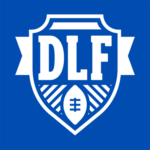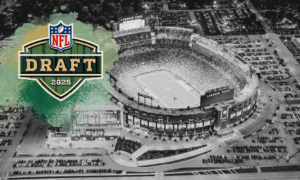2018 Wide Receiver Combine Analysis: Part Two
If you glance outside for any of the states in the northern half of the country it definitely looks like it is football season. Unfortunately, it is April which means we have a bit of a wait. However, the NFL Draft is a much-needed oasis that isn’t too far away. To help us prepare, it is time for my annual analysis of the wide receiver draft class. The metric isn’t perfect, but if it is used the correct way, I think it can be a great tool.
Speaking of the metric, before I go any further, you can see that this is part two of a series. If you haven’t read part one yet, stop right now and click the link. Otherwise, you’re going to be completely lost on what is going on. In fact, even if you already read part one you might want to go back for a quick refresher.
In part one, I outlined the general process I’m using, my goals, my disclaimers and took a look back at recent draft classes to help give you an example of what this metric tells you. I’m going to trust that you actually looked at all of that and get right down to business with the current draft class.
I’m going to talk a bit about most of the meaningful prospects and what they bring to the table, both in terms of their physical traits and their other abilities. For the top receivers, I’m going to push them to a special article because they deserve a little extra attention in my eyes.
Keep in mind that a score of a zero is the average for the best wide receivers in the NFL, so there is absolutely nothing wrong with being around zero or even a little bit negative. Where I start getting concerned is when a player gets below a -2 and especially when they are below a -4. The score in the parenthesis is the score without height and arm length factored in for those who feel height is overrated.
Also, not all players participated fully in the combine. If you see an asterisk next to their name, they missed at least two drills at the combine, so their score might not be 100 percent accurate. On with the show!
[am4show have=’g1;’ guest_error=’sub_message’ user_error=’sub_message’ ]
Top Dog
DJ Moore: 3.93 (5.39)
There is the perception that as a whole, this is a much weaker wide receiver class than many of the past years. This is part of why several of us are forecasting five of the top six picks in this year’s rookie drafts to be running backs. Is this weakness a perception or a reality? Well, this metric shows it just might be a reality.
In most years, the top scorer by the metric is above a five with a handful of players in the 2-5 range as well. With the top player in this year’s class not even topping a 4 in height based scoring, and only two other players even over a 2, this is definitely one of the weaker groups we have seen from a ceiling standpoint in quite some time.
Being the top scorer doesn’t always mean great things. Sometimes it is just a workout warrior who doesn’t have the film to back it up. Chris Conley (7.43), Devon Cajuste (7.04), and Robert Davis (5.49) have been the top scorers over the last three years. With the possible exception of Conley, all of them were fringe NFL players based on their tape who blew up the combine. While these players make great fliers in the last round of your rookie draft, you can’t expect them to be superstars.
However, when a top prospect does score super high, it really gets my attention. For example, players like Odell Beckham (5.51) and Julio Jones (8.13) lead their respective draft classes with massive numbers. While Moore’s number isn’t nearly at their level, the fact that he scored in the nearly 4 range speaks to his upside. He definitely has the athletic ability to be a WR1 in the NFL.
I’ll talk a lot more about Moore in the top prospects article at the end of this series.
Great Scores (Better than +2. Vincent Jackson, Larry Fitzgerald, Amari Cooper)
Dylan Cantrell: 3.82 (3.09)
Courtland Sutton: 2.73 (2.26)
A lot of you just went, “Who?” followed by, “I knew it!” when you read those two names as being the next two guys in this draft class. Maybe you are a Texas Tech fan and you know a little bit about Cantrell, but otherwise, that was probably your reaction. The fact that only two receivers are in this group again speaks to the lack of great athletic talent at the position this draft class. Some years, there are as many as five or six players with scores in the two or more range. Not this year. I’ll speak more about Sutton in my top prospects article at the end of the series, so let me focus in a little bit on Cantrell.
As I mentioned, he played his college ball at Texas Tech. He is a bigger receiver (as you can tell by the height score being almost a full point better than the non-height score) at 6’3” and 212 pounds. He grew up in Texas, and he went to his home state college where he played immediately as a true freshman. Unfortunately, his impact early on was pretty limited. He caught only 29 passes during his first two years combined before missing his entire third year with a back injury. He grew into a bigger role over his last few years though with 58 and 71 receptions over his last two years. However, he averaged about 11.5 yards per reception over those last two years, which isn’t going to blow anyone away.
As a player, he has nice hands and seems to have a great feel for the position. He uses his size well, both in the middle of the field and on the sidelines. He is a great leaper who wins most contested situations. When you combine all of that with his score in the metric, you might be wondering why he is a fringe NFL prospect.
I think it likely comes down to the same thing as Conley, Cajuste, and Davis who I mentioned above. Cantrell tests better at the Combine than how he plays. He showed great quickness and change of direction ability in the shuttle and 3-cone drills. However, he really struggles to separate during a game. Maybe he can refine his technique and improve upon that at the next level, but it is a bit of a long shot. For the time being, he is a solid late-round flier if your league has larger rosters or taxi squads.
Good Scores (Positive scores, but lower than a 2. Mike Evans, Michael Crabtree, Dez Bryant, Allen Robinson)
*Anthony Miller: 0.90 (2.79)
J’Mon Moore: 0.73 (-0.15)
*DJ Chark: 0.40 (-0.06)
With the zero to two range, we are looking at the last group of players who are above the average of the baseline group. This doesn’t mean these players are slightly above average. This means that these players are slightly above average physically when compared to WR1s and WR2s. That’s pretty good! This means these guys have a ceiling of being somewhere in the WR2 conversation if all goes well for them. The fact that only three players are in this category – bring the running total to six – continues to speak about the weakness in this year’s draft class.
Unfortunately for the metric, two of the three receivers in this group have incomplete scores. The vast majority of the time, when a player skips a drill, it is because they know it isn’t going to help them. So anytime a player has multiple absences, their score is probably a little bit lower. With that said, let’s dive a little bit more into this group.
Miller, the top player in this grouping, is someone you want to cheer for based on his background. As someone who went from college walk-on to school record holder, you have to love the story. Thickly built with massive hands, Miller has some things you definitely look for in a receiver, especially when you combine that with his massive college production. He is a definite playmaker who dominated his competition.
The concerns are that he faced lower competition levels for much of his career, and he was much older than most of the people he was playing against. If you are someone who subscribes to the breakout age theory, he is going to give you some pause. Overall, I’m looking at him as a late second or early third round target. He has the ability to come in and be the third receiver on an NFL team right away, but I’m not sure he can be super productive.
J’Mon Moore, not to be confused with DJ, is a bit of a rarity physically. A tall receiver at 6’3”, he is a bit on the lean side with small hands for someone of his height but very long arms. His Combine results are equally mixed. He did very well in the change of direction and acceleration drills, but his straight-line speed is suspect after a 4.6 second time in the 40-yard dash.
If you look at his film, I think he is someone who is very quick with his breaks and his first step, but might not be quite as fast on the top end as we thought. He is going to need to refine his route running and work on his drops a bit if he is going to be productive at the next level, but he could be a very sneaky late-round target in rookie drafts if you have room to stash him.
As for Chark, I will discuss him later. He’s inside my top seven wide receivers, so he will be a part of the special follow-up article on the top prospects in this draft class. The short version is while him missing drills does make his score a little incomplete, he does fit the physical profile of a WR2 in the NFL. He has holes in his game, but most of them can be fixed.
Respectable Scores (Between -2 and 0. Marques Colston, Greg Jennings, Sammy Watkins)
*Allen Lazard: -0.09 (-1.32)
*Equanimeous St. Brown: -0.44 (-2.30)
DaeSean Hamilton: -0.94 (-0.80)
*Cam Phillips: -1.09 (-0.52)
*Darren Carrington: -1.22 (-1.56)
*Marquez Valdes-Scantling: -1.56 (-2.35)
Tre’Quan Smith: -1.93 (-2.79)
At the risk of sounding a little bit like a broken record, the overall size of this grouping is much smaller than in past years. Looking back over the data, most years have about 12-15 players in this grouping with about the same amount scoring higher than this. This really isn’t the case this year, which continues to support the idea that this is a much weaker wide receiver draft class than the last few years.
In regards to the score, this group is on the slightly negative side of the metric. If you’re wondering why I called these respectable scores, keep in mind that a 0 is the exact average of weekly fantasy starters. Being slightly below that mark still means these players have a WR2 type of upside if they can refine and perfect the other parts of their game like route running. Overall, this is about the end of the good news for the receiver class, because players who are below a -2 have a poor track record of fantasy relevance. The only glaring exception to this is if they are an undersized receiver.
I’ll be addressing St. Brown in the follow-up article since he is one of my top seven receivers, but let’s take a look at the rest of the group.
Lazard was the top player in this grouping, and he is an intriguing prospect. I have him just outside of my top ten receivers, but my five through 15 are still very fluid right now. Lazard is an absolute physical specimen at 6’5” and 227 pounds. The fact he was able to run a 4.55 second time in the forty yard dash and have a vertical leap of 38” at that size just adds to the intrigue. The fact he turned down scholarship offers from many top programs to follow his family legacy at Iowa State shows a certain depth of character to me as well.
Where things get a little less appealing is his change of direction and acceleration skills. This seems to be a weakness of his if you watch him play, and I would have loved to see those drills at the combine but he skipped them. He struggled to separate in college, and I think it is largely due to him being a very straight-line player. Maybe he can work on this in the NFL, but I have a bad feeling this is just who he is as a player, making him more of a sub package/red zone player. He could always try to add a little more weight and play tight end as well.
The Penn State receivers were and continue to be overshadowed by the brilliance of the other skill positions, but Hamilton is worth at least some consideration near the end of your rookie draft. He profiles as a bigger slot receiver at the NFL level, and by all accounts is a high character, team-orientated guy. All of this could help him earn playing time sooner rather than later. He is good but not great from an athletic profile, so he is going to need to continue to polish his route running ability.
Overall, I think he is most likely to be one of those players who is more valuable to their NFL team than to a fantasy team. He will be highly coachable and very willing to play on special teams or anywhere else the coaches want him. With that said, he is still a late-round target in PPR leagues due to his potential to be a chain mover.
Philips, Carrington, and Valdes-Scantling can all be lumped together because they are all players with incomplete scores due to skipped drills. They are also fringe NFL prospects who are unlikely to be solid fantasy prospects. If I had to pick one of the three to be on my roster, I would probably go with Valdes-Scantling purely for the size/speed potential. At 6’4, he was able to run a 40-yard dash in 4.37 seconds. All three of these players have issues in their game, but you can’t coach size and you can’t coach speed.
The final player in the group is Tre’Quan Smith. As a member of the “2017 National Championship team” of Central Florida, Smith was highly productive this past year. He showed well on the field, especially in jump ball situations and making defenders pay for their mistakes. However, there were some issues with drops and at times not making the difficult catches outside of his frame. Of course, there were highlight reel catches as well, so it might be a simple matter of focus and concentration.
According to the drills, he has decent long speed, leaping ability, and change of direction. Where he is lacking is in his ability to accelerate quickly, which showed at times in college when he was trying to beat tight coverage or create separation with his routes. I think he will definitely make a team but will be the third or fourth receiver. He will likely need some injuries or a few years before there is any fantasy value.
I’ll be back with part three of this series, where I start to look at the receivers who scored below a -2. This is the point where I start to get a little more concerned about their ability to produce at the NFL level. It is still definitely possible, but as that number gets lower and lower, their ceiling starts to decrease dramatically as does their chances of being a consistent fantasy asset. If you haven’t seen a receiver so far, it means they either fall into this group or they didn’t participate in the Combine. If it is the former, think carefully about what kind of upside they bring to your team. I’ll be back to share my thoughts on that very question. Make sure you check it out!
[/am4show]
- Final 2021 Pre-Draft Rookie Mock: Round Three - April 28, 2021
- Final 2021 Pre-Draft Rookie Mock: Round Two - April 26, 2021
- Final 2021 Pre-Draft Rookie Mock: Round One - April 25, 2021
























































